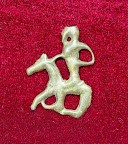A new exhibition with the generic "Hansca - archaeological site and school-site (50 years from the beginning of research)" was opened to the large public at the National Museum of History of Moldova.
The exhibition reunites about 300 archaeological objects, the most representative from HANSCA collection, which have scientific, documentary, historic and esthetic value.
The pieces included in the exhibition are authentic with only a very small number of objects being subject to some obvious procedures of restoration and conservation. They reflect economic activities displayed through tools of metal, bone, clay or stone; the esthetic taste shown through clothing and adornment objects; religious representations reflected through miniature pieces, anthropomorphic and zoomorphic and through the „magic kit", all dated with the 4th-3rd centuries BC.
Religious beliefs from the Middle Ages are represented by a cross made from wire and a Byzantine type encolpion. Exchange and commercial relations with the Greek and Roman world, and with the Byzantine and Slavic world later in the Medieval period, are documented by objects of glass, bronze and silver.
The original exhibits are accompanied by panoramic or detailed photographic images which reflect the archaeological investigations conducted by researchers and the active participation of students.
Dedicated to the semicentenary from the first archaeological excavation at the site from Hansca, the exhibition is a tribute to all those who through their dedication and perseverance contributed essentially to the valorification of national archaeological heritage and to an objective reconstruction of historic process.
One of the most important sites with objectives of great scientific interest for the archeology and history of Romanian space east of Carpathians has been discovered and investigated near Hansca village, Ialoveni district. The site from Hansca has been identified in 1959. Already in 1960 were conducted the first surveys and were discovered remains of habitat from Getae-Dacian and early medieval periods.
Systematic archaeological investigations at the site from Hansca began in 1964 and continued during 20 archaeological campaigns. As a result of the excavations a total surface of several thousands of square meters has been uncovered. There were discovered remains dated with the late Bronze Age (Noua culture); early Hallstatt (Tămăoani-Holercani culture); Getae culture; Sântana de Mureș-Cernjahov culture and early and developed medieval period.
Starting with the dimensions of the researched area and the number and diversity of discovered archaeological material, the site from Hansca is rightfully considered to be as one of the most representative ancient and medieval monument from Carpathian-Dniester space.
The site from Hansca played a very special role as archaeological site and school. Here, during the entire period of research, tenth of generations of students from history departments conducted their compulsory archeological internship. At Hansca, the students, many of whom later became renowned archaeologists in the Republic of Moldova, have learned and practiced excavation techniques, methods and methodologies of heritage and artifacts management.






















































